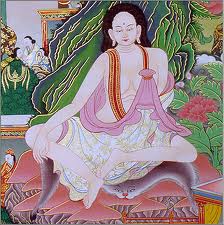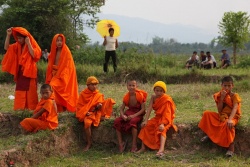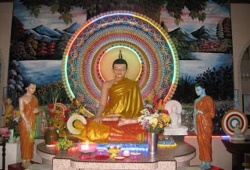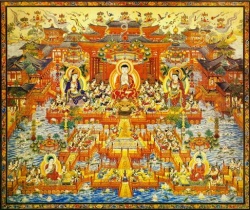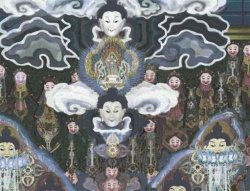Amitayus
[[Image:Amitayus red.jpg|thumb|250px|Amitayus, from the private collection of Sogyal Rinpoche)]
Amitayus (Skt. Amitāyus, Tib. ཚེ་དཔག་མེད་, Tsepakmé; Wyl. tshe dpag med), 'The Buddha of Boundless Life' — a sambhogakaya aspect of Amitabha, particularly associated with longevity.
He is mostly depicted sitting and holding in his hands a vessel containing the nectar of immortality. Amitayus is also one of the three deities of long life.
po tshe dpag med- Protector Amitayus Boundless Life [RY]
sgyu 'phrul tshe dkar - Gyutrül Tsekar. One of the termas revealed by Chokgyur Lingpa which focuses on White Amitayus [RY]
chos sku tshe dpag med - Dharmakaya Amitayus [RY]
'chi ba mthar byed - Maratika. The sacred place in eastern Nepal where Guru Rinpoche and Mandarava were blessed with immortal life by Buddha Amitayus [RY]
'chi med rdo rje'i ting nge 'dzin - Immortal vajra samadhi. The indestructible composure of the Buddha of Limitless Life, Amitayus [RY]
nye brgyud tshe rta zung 'brel 'chi med dpal gter - Amitayus and Hayagriva Combined, sadhana of, by Tangtong Gyalpo [RY]
spyod rgyud tshe dpag med - Amitayus according to Charya Tantra [RY]
(bar chad kun sel kyi chos skor) - Here is a short introduction to the Barchey Künsel cycle: The Barchey Künsel is the heart essence of the accomplished master Padmasambhava who perceives the three times in their entirety. It is the quintessence of one billion heart sadhanas of the Guru, the most unique terma buried in the land of Tibet; and it is the first among the Four Cycles of Guru Sadhana.
This Guru's Heart Practice, Dispeller of All Obstacles contains in completeness all the profound key points of the view, meditation and conduct of the Three Inner Tantras. It manifested from the secret treasury of the great wisdom, the vast realization of the Second Buddha of Uddiyana, as the self-existing natural vajra sounds in perfect melodious tones. I
ts expressions which are unmodified by the intellect of ordinary people, its words which are without delusion, and its meaning which is unmistaken, are exclusively due to the kindness of the three powerful knowledge-holders Khyentse, Kongtrül, and Chokling, the great beings of the three families, who incarnated as masters to compile and propagate an ocean of secret teachings. It is exclusively through their kindness that this teaching was established in writing as the splendor of unending welfare and happiness for the disciples in the Land of Snow, and propagated to flourish everywhere.
This pure and perfect teaching, which effortlessly bestows, in accordance with one's wishes, the all-encompassing supreme and common siddhis, temporarily and ultimately, was an unprecedented diffusion of the gemstones of the profound meaning, like opening up for the treasury of the universal monarch. Dilgo Khyentse Rinpoche About the Barchey Künsel practice, which is the first and most extensive of the Four Cycles of Guru Sadhana, Jamgön Kongtrül says in his Seed of the Great Sal Tree: "Generally, for the basic descriptions of how to practice this, take the third chapter taught in the Sheldam Nyingjang as basis and apply them, following your teacher's oral advice, in the extensive, medium or short version, whichever is appropriate, and in accordance with the situation in terms of place, time, and type of person.
Whether you begin with the development stage or completion stage, first perform the general preliminaries of the fourfold mind-training and the four special preliminaries. For the main part, according to the system of Terchen Chokgyur Lingpa, take Sheldam Nyingjang as basis, and first practice Dharmakaya Amitayus followed by the Lotus Magical Net of Sambhogakaya, the Great Compassionate One Avalokiteshvara.
After this, combine the extensive or medium version with the Nirmanakaya Padmasambhava, whichever is suitable, and complete the set number [of recitations] for approach and accomplishment. Following that, it is necessary to perform successively the specific approaches, combining the twelve manifestations with Trinley Nyingpo, and complete the four activities and the four ancillary practices as well as the practice of the teaching guardians.
According to the system of the omniscient master, Padma Ösel Do-Ngak Lingpa [ Jamyang Khyentse Wangpo ], perform, as the beginning of the main part, the single mudra according to the Gyüngyi Köljang, the Daily Practice Manual, as 'approach'; the condensed outer mandala of Trinley Nyingpo as the 'full approach;' Trinley Dringpo, the Medium Practice Manual, as 'accomplishment;'
and Trinley Gyepa, the Extensive Practice Manual, together with Dzapkyi Köljang, the Recitation Manual, and so forth in a detailed way for the 'great accomplishment.' The samadhis and visualizations for recitation of these should conform with the root text of the third chapter [of Sheldam Nyingjang. Having properly performed the four aspects of approach and accomplishment, perform then the 'specific practices' such as those for Dharmakaya, Sambhogakaya and so forth, whichever is suitable. There is no difference between following either of these two systems since they both are lords of these profound teachings." [RY] ma ra ti ka - Maratika. The sacred place in eastern Nepal where Guru Rinpoche was blessed with immortal life by Buddha Amitayus [RY]
tshe dkar - White Amitayus, {tshe dpag med dkar po} [RY]
tshe dkar sgrub skor - revealed by mchog gyur gling pa - gter ston, 1829-1870. Comprises texts from the rediscoveries of Chokgyur Lingpa, with liturgical notes by kong sprul blo gros mtha' yas and others. Collection of ritual texts to be recited to ensure longevity focusing upon a white form of Amitayus; from the liturgy of the Nyingmapa sect [RY]
tshe skor - set of teachings connected to Amitayus etc [RY]
tshe rta zung 'brel - Sadhana of Amitayus and Hayagriva Combined [RY]
tshe rta zung 'brel - Amitayus and hayagriva conjoined [IW]
tshe rta zung 'brel - Amitayus and Hayagriva conjoined [RY]
tshe mdo - the Amitayus Sutra [RY]
tshe dpag med - Boundless life, Amitayus [IW]
dpag med - Amitayus, the Buddha of Boundless Life [RY]
tshe dpag med - Amitayus [[[name]] of Buddha]. Boundless Life, Amitayus / Buddha of Boundless Light associated with the long-life initiation / sambhogakaya aspect of Amitabha, spiritual source from which Avalokiteshvara emanates [RY]
tshe dpag med- Amitayus [RY]
tshe dpag med mgon - Protector Amitayus [RY]
tshe dpag med pa - Skt. Amitayus - Boundless Life. 1) Buddha Amitayus. 2) A Mahayana sutra [RY]
tshe gzungs - Amitayus Dharani [RY]
tshe lung - reading transmission for Amitayus mantra [RY]
tshe lha rnam gsum - the three deities of longevity: Amitayus, White Tara, and Namgyalma
See Also
External Links
Source
Buddha Amitayus (tshe dpag med) Lit. 'Buddha of Boundless Life; the Sambhogakaya aspect of Amitabha. The buddha associated with the 'empowerment of longevity' and longevity practice.
Source
Amitayus
阿弥陀仏・無量寿仏 (Skt; Jpn Amida-butsu or Muryoju-butsu)
The Buddha Infinite Life or the Buddha of Infinite Life. The Sanskrit name of Amida Buddha, the Buddha of the Pure Land of Perfect Bliss in the west.
Source
Amitāyus. (T. Tshe dpag med; C. Wuliangshou fo; J. Muryōju butsu; K. Muryangsu pul 無量壽佛). In Sanskrit, the buddha or bodhisattva of “Limitless Life” or “Infinite Lifespan.”
Although the name originally was synonymous with Amitābha, in the tantric traditions, Amitāyus has developed distinguishing characteristics and is now sometimes considered to be an independent form of Amitābha.
The Japanese Shingon school, for example, uses Muryōju in representations of the Taizōkai (garbhadhātumaṇḍala) and Amida (Amitābha) in the Kongōkai (vajradhātumaṇḍala).
Amitāyus is often central in tantric ceremonies for prolonging life and so has numerous forms and appellations in various groupings, such as one of six and one of nine.
He is shown in bodhisattva guise, with crown and jewels, sitting in Dhyānāsana with both hands in Dhyānamudrā and holding a water pot (kalaśa) full of Amṛta (here the nectar of long life); like Amitābha, he is usually red.
Source
The Princeton Dictionary of Buddhism by Robert E. Buswell Jr. and Donald S. Lopez Jr.
See Also
Articles containing word "Amitayus" in title
- A Daily Long-Life Practice of Amitāyus by Dudjom Rinpoche
- Amitabha/Amitayus Buddha
- Amitabha and Amitayus
- Amitayus.
- Amitayus - Buddha of Limitless Life
- Amitayus Buddha
- Amitayus Buddha Mantra
- Amitayus Dhyana Sutra
- Amitayus Long-life Practice Lama Caroline
- Amitayus Long Life Sutra
- Amitayus Mantra
- Amitayus Meditation Sutra
- Amitayus Praise Mantra
- Amitayus dhyana Sutra
- Amitayus in Gandhara
- Amitayus mantra
- Amitayus of Nyala Pema Duddul
- Amitayus sutropadeśa
- Amitābha and Amitāyus Mantra
- Amitāyus
- Amitāyus Dhāraṇī
- Amitāyus Meditation Sutra
- Amitāyus Series
- Amitāyus Sūtra
- Buddha Amitayus
- Buddha Amitayus/Amitabha
- Buddha Amitayus/amitabha
- Buddha Amitayus (Tib: Tsepagme)
- Buddha Amitāyus
- Buddha Pronounces the Sūtra of Visualization of Amitāyus Buddha
- Buddha amitayus/amitabha
- Caturbhuja-Amitāyus
- Circles of light’ and ‘treasure ships’ in the Visualizing Amitāyus Tableaux: with a focus on some cases in Sichuan from the Tang and Five Dynasties period
- Consort of Amitayus
- Dharmakaya Amitayus
- Long Life Amitayus Meditation.
- Prayer and Mantra of Buddha Amitayus. Jig-Ten Dren-Pey Tso ...
- Prayer to Amitayus
- Short Amitayus Practice
- Sutra On The Contemplation Of Buddha Amitayus
- Sūtra of Amitāyus Buddha
- Sūtra of Visualization of Amitāyus Buddha
- Sūtra on the Contemplation of Buddha Amitāyus
- The Nectar of Life - practice of Buddha Amitayus
- The Sutra On Contemplation Of Amitayus
- The Sutra on contemplation of Amitayus
- Transcript: Amitayus Sadhana practice
- True Buddha Dharmalaksana Canon On Amitayus Buddha Sadhana
- Upadeśa on the Sūtra of Amitāyus Buddha
- Visualization of Life-Extending Amitayus
